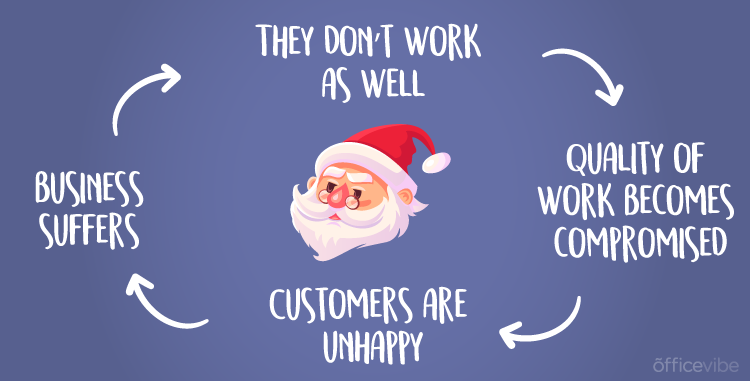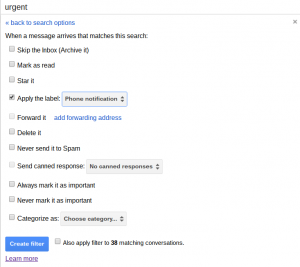
One mindset that all great leaders have is that there is always more learning to do.
Greatness is not static.
The very best leaders are constantly developing, changing, improving and becoming.
Even Santa…
After analyzing the ins and outs of Santa’s workshop, here are some things he can work on in order to become a better leader next year.

Hire Enough Employees
Santa’s elves have needed to work extra long days, answer their emails on off hours, come in on weekends and forego vacations for the sake of getting everything out by the 24th, because there just isn’t enough elf power in the workshop to get everything done.
According to this Harvard Business Review article, working too many hours can actually backfire for companies, because exhausted and underappreciated employees do not make for quality work.
There’s a large body of research that suggests that regardless of our reasons for working long hours, overwork does not help us. For starters, it doesn’t seem to result in more output. [And] considerable evidence shows that overwork is not just neutral — it hurts us and the companies we work for.
The solution to this problem isn’t to overwork the staff you have. Instead, either find a way to work more efficiently or if needs be, increase the size of your staff.
You cannot expect one person to do the job of two people, but this happens often.
What happens when employees are overworked?

When employees feel the weight of being overworked (especially without appreciation) they might decide to leave the company altogether, which would require you to spend time and money on recruitment and onboarding.
As the old adage goes…
Sometimes you have to spend money to make money.
Consider it an investment in the future, not a loss, as creating a more manageable workflow for your employees by adding power to the team will help cultivate a more stress-free environment, happier employees, and therefore better end results.
Communication
“The single biggest problem in communication is the illusion that it has taken place” – George Bernard Shaw
Communication is one of the main, if not the most important life force of the workplace.
Without it, even the most efficient systems won’t succeed.
When changes are made (big or small) the rest of the team needs to know. There has to be a constant flow and connectivity in the workplace, achieved through communication.
Santa learned this the hard way when he made changes to the naughty and nice list but neglected to tell the elves.
This resulted in not enough gifts being made, and elves needing to work overtime on the weekend, to no fault of their own.
According to a study conducted by Interact, 69% of managers are not comfortable communicating with employees.
That is a shockingly high percentage.
Here are some simple ways to communicate better:
- Implement simple inter-office communication tool like Slack that make it fun and easy to be in touch with your team all day.
- Hold daily meetings where each team member recap on important points and what needs to get done.
- Be mindful of your team members and grateful for your employees. Your actions and decisions affect them, so be sure to give them all the information they need to succeed.
Avoid Favouritism
Playing favourites at work can be very hurtful for employee and dangerous for the vibe and culture of the office.
The truth is, it never ends well. While it’s great to have friends at work and socialize with your employees both in and out of the office, there is a line that should not be crossed.
This article by Forbes discusses the dangers of favouritism well:
Managers who have fallen into the trap of favoritism may also overlook or excuse lesser-quality of work or spend personal time with select employees while excluding others. Although these may seem like small issues from the perspective of the manager, they are not viewed that way by employees.
As a manager, if you treat your star employees the best (like Santa does with Rudolph), you risk discouraging the other employees from improving and you also risk seeing said employee objectively, which might allow them to get away with some less than par work.
All employees should be treated equally, and if any extra attention is going to be given, it should be by spending time with the employees that might need the extra encouragement and help.
Make The Workplace Healthy
Having snacks at work is a great idea. Food can fuel you to keep going by providing you with energy, but there are some foods that will actually slow you down.
Filling the workplace kitchen with junk food like chips, candy and chocolate might seem like a nice treat to your employees, but the truth is that sugar, like caffeine, can result in you crashing.
Santa’s elves have been snacking on candy canes and hot chocolate all year round and are starting to feel lethargic and unproductive.
This is how Officevibe does health:
- At Officevibe, we have crates of fruit like apples, oranges, pears and bananas available all week to employees.
- Most recently, we installed yogurt and granola stations by Oatbox, so we’re sure to have a nutritious breakfast every morning.
- Three days a week, individual healthy lunches are delivered to the office.
- Every employee is given a Nalgene bottle to encourage drinking as much water as possible during the day.
These are just some ways to promote a healthy workplace. A good and inexpensive start would simply be to replace sugar-filled, unhealthy snacks with healthy ones like vegetable platters and dip or cheese and crackers, for example.
Give Monthly Feedback
Santa’s workshop is a great example of a workplace that is busy year round and under pressure to meet a big deadline.
Often, these types of workplaces find it difficult to offer frequent feedback because there doesn’t seem to be enough time.
So, they wait until the end of the year to offer annual performance reviews instead (once all the big projects are out of the way).
However, this one-time-a-year feedback is becoming more and more obsolete as companies are realizing that annual performance reviews are problematic.
Waiting until the end of the year to give a review doesn’t work because things have become irrelevant, and a lot slips through the cracks of our memory.
And think about it, what would be the point of giving feedback to say, hockey players, after the game, instead of calling time-outs during? It would be too late.
Finding the time for monthly feedback sessions or even weekly check-ins – even in the busiest of schedules – is critical to the success of your company.
Why giving frequent feedback is key:
- It lets employees know where they’re at, and allows them to fix things right away, so they are in a constant state of improvement.
- It lets employees express concerns, giving them a voice.
- It’s a good way to set monthly goals, like OKRS that can be measured, so employees are not working blindly but towards a vision.
- It keeps the relationship between manager and employee current and relevant, and keeps conversation and communication flowing.
All that said, implementing frequent feedback into your workplace routine is well worth those 10 minutes away from the workstation as it is a long-term investment in the company’s future.
Respond To Feedback
Responding to feedback is as important as giving it. You want your employees to feel that they can talk to you, bring up concerns, share insights, pitch ideas, etc.
But, if they reach out to you and you either don’t get back to them or give them a half-baked response, you risk jeopardizing an open, honest, relationship.
When you give feedback to employees, you expect that they listen, respond and implement. The same goes for managers, and this reciprocation is key to making sure your employees feel valued and seen.
Santa gets letters year round from all corners of the world, so of course it’s hard to get to everyone in a timely manner. But, putting customers before employees will have negative long terms effects.
As we said earlier…
Employee Experience = Customer Experience
In a way, your employees are like your customers because their happiness plays a part in the happiness of your actual customers.
If your employee reaches out to you with anything from a “hello” to an issue they want to discuss – be available to them to the best of your ability. And, make sure that your “open door policy” is truthful – not just fluff.
Share The Credit
Santa is a celebrity. Everyone knows him and associates him with the big day and all the perks and goodies that come with it.
But what about the elves? The ones who made all the gifts, worked the long hours and quality checked each toy.
It’s not necessarily Santa’s fault that he is the face of the holiday (often, this is just how it goes – not every contributor can be praised publicly), however, it is important to share the credit, thanks and praise with the team.
This will keep employees motivated and encouraged to keep putting in their best work.
A little bit of thanks goes a long way.
Business & Finance Articles on Business 2 Community(56)







